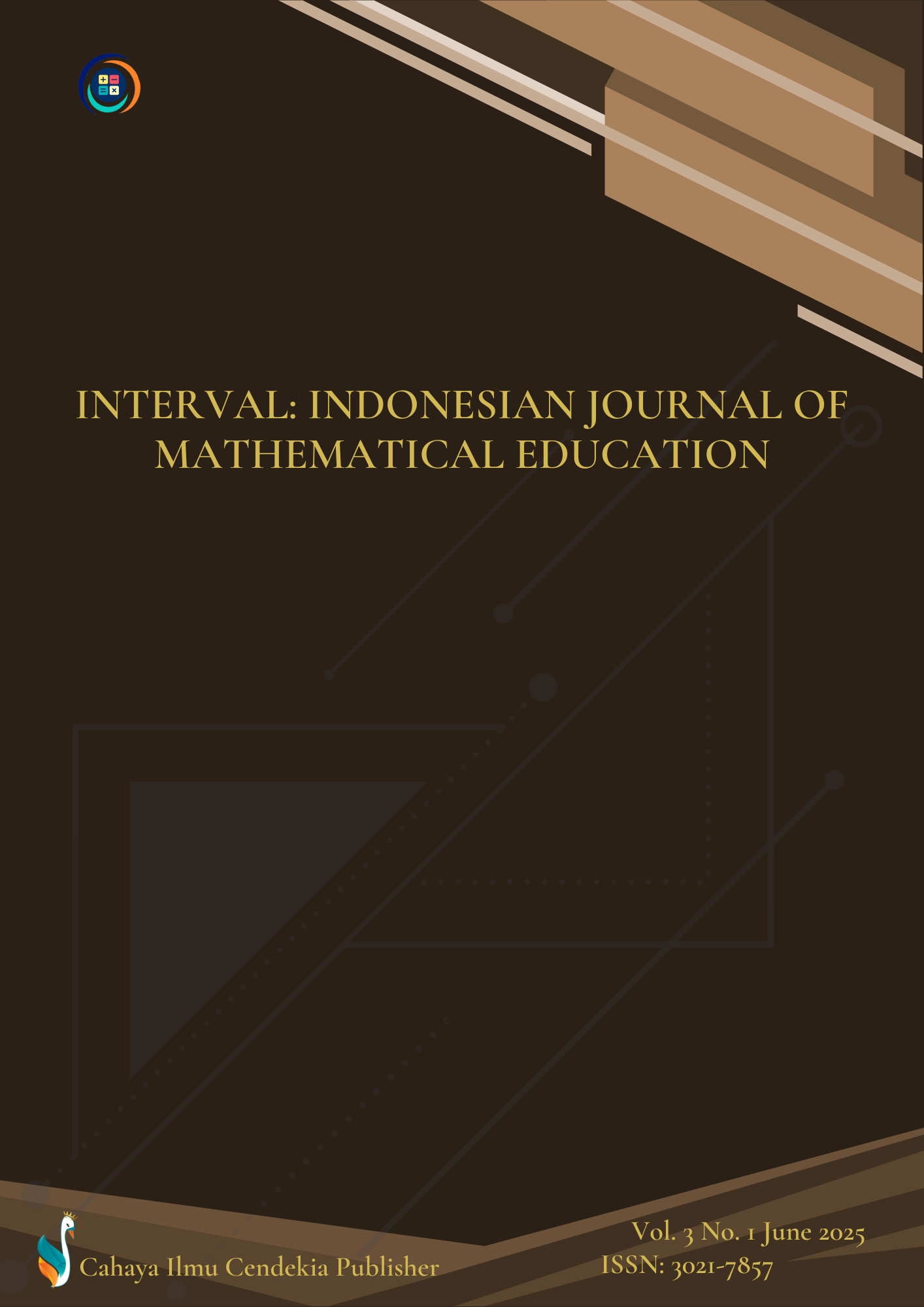Modeling the Spruce Budworm Population: A Numerical Approach Using Heun and Runge-Kutta Methods
Abstract
Purpose of the study: The purpose of this study is to determine the numerical solution of the spruce caterpillar model using the Heun method and the Third Order Runge-Kutta method, as well as to analyze the errors associated with both methods.
Methodology: The type of research used in this study is library research. In this study, the data will be analyzed numerically from the data entry stage, data processing and results. The results obtained are from the Heun programming method and the Runge iteration method that have been determined previously. Kutta-Order Three will produce data with the smallest error in the number of.
Main Findings:The results of the study showed the solution of the Pinus Lice model for the initial values of B(t₀) = 2, S(t₀) = 10 cm, E(t₀) = 2 cm, at t = 5 years, with h = 0.05. Using the Heun method, it was obtained that B ≈ 3, S = 14.9058 cm, and E = 1.0047 cm, while the Third Order Runge-Kutta method produced B ≈ 3, S = 14.9057 cm, and E = 1.0046 cm. The error calculation showed that the B error was smaller with the Heun method, while the S and E errors were smaller with the Third Order Runge-Kutta method.
Novelty/Originality of this study: The novelty of this study lies in the comparative analysis of the errors of the Heun Method and the Third Order Runge-Kutta Method in modeling the dynamics of spruce budworm populations with specific biological parameters.
References
P. Sharma, “Importance and Application of Mathematics in Everyday Life,” Int. J. Res. Appl. Sci. Eng. Technol., vol. 9, no. 11, pp. 868–879, 2021, doi: 10.22214/ijraset.2021.38869.
E. Supriyadi and K. S. Kuncoro, “Exploring the future of mathematics teaching: Insight with ChatGPT,” Union J. Ilm. Pendidik. Mat., vol. 11, no. 2, pp. 305–316, 2023, doi: 10.30738/union.v11i2.14898.
S. Papadakis, M. Kalogiannakis, and N. Zaranis, “Teaching mathematics with mobile devices and the Realistic Mathematical Education (RME) approach in kindergarten,” Adv. Mob. Learn. Educ. Res., vol. 1, no. 1, pp. 5–18, 2021, doi: 10.25082/amler.2021.01.002.
B. Mainali, “Representation in teaching and learning mathematics,” Int. J. Educ. Math. Sci. Technol., vol. 9, no. 1, pp. 1–21, 2021, doi: 10.46328/ijemst.1111.
R. Berner, T. Gross, C. Kuehn, J. Kurths, and S. Yanchuk, “Adaptive dynamical networks,” 2023. doi: 10.1016/j.physrep.2023.08.001.
N. Gardenia, T. Herman, D. Juandi, T. Dahlan, and T. Kandaga, “Analysis of mathematical communication skills of class 8 students on two-variable linear equation systems (SPLDV) concept,” J. Phys. Conf. Ser., vol. 1806, no. 1, pp. 1–7, 2021, doi: 10.1088/1742-6596/1806/1/012073.
M. Cevikbas, G. Kaiser, and S. Schukajlow, A systematic literature review of the current discussion on mathematical modelling competencies: state-of-the-art developments in conceptualizing, measuring, and fostering, vol. 109, no. 2. Springer Netherlands, 2022. doi: 10.1007/s10649-021-10104-6.
M. Jdid, A. A. Salama, and H. E. Khalid, “Neutrosophic Handling of the Simplex Direct Algorithm to Define the Optimal Solution in Linear Programming,” Int. J. Neutrosophic Sci., vol. 18, no. 1, pp. 30–41, 2022, doi: 10.54216/IJNS.180104.
W. Quaghebeur, E. Torfs, B. De Baets, and I. Nopens, “Hybrid differential equations: Integrating mechanistic and data-driven techniques for modelling of water systems,” Water Res., vol. 213, no. February, pp. 1–16, 2022, doi: 10.1016/j.watres.2022.118166.
G. Q. Sun et al., “Mathematical modeling and mechanisms of pattern formation in ecological systems: a review,” Nonlinear Dyn., vol. 104, no. 2, pp. 1677–1696, 2021, doi: 10.1007/s11071-021-06314-5.
C. Legaard et al., “Constructing Neural Network Based Models for Simulating Dynamical Systems,” ACM Comput. Surv., vol. 55, no. 11, pp. 1–35, 2023, doi: 10.1145/3567591.
J. Blechschmidt and O. G. Ernst, “Three ways to solve partial differential equations with neural networks — A review,” GAMM Mitteilungen, vol. 44, no. 2, pp. 1–29, 2021, doi: 10.1002/gamm.202100006.
L. Yuan, Y. Q. Ni, X. Y. Deng, and S. Hao, “A-PINN: Auxiliary physics informed neural networks for forward and inverse problems of nonlinear integro-differential equations,” J. Comput. Phys., vol. 462, p. 111260, 2022, doi: 10.1016/j.jcp.2022.111260.
Y. Kai, S. Chen, K. Zhang, and Z. Yin, “Exact solutions and dynamic properties of a nonlinear fourth-order time-fractional partial differential equation,” Waves in Random and Complex Media, vol. 35, no. 2, pp. 1–14, 2022, doi: 10.1080/17455030.2022.2044541.
S. T. Abdulazeez and M. Modanli, “Analytic solution of fractional order Pseudo-Hyperbolic Telegraph equation using modified double Laplace transform method,” Int. J. Math. Comput. Eng., vol. 1, no. 1, pp. 105–114, 2023, doi: 10.2478/ijmce-2023-0008.
H. Badawi, N. Shawagfeh, and O. Abu Arqub, “Fractional Conformable Stochastic Integrodifferential Equations: Existence, Uniqueness, and Numerical Simulations Utilizing the Shifted Legendre Spectral Collocation Algorithm,” Math. Probl. Eng., vol. 2022, 2022, doi: 10.1155/2022/5104350.
G. M. Moatimid and T. S. Amer, “Analytical Approximate Solutions of a Magnetic Spherical Pendulum: Stability Analysis,” J. Vib. Eng. Technol., vol. 11, no. 5, pp. 2155–2165, 2023, doi: 10.1007/s42417-022-00693-8.
M. A. Alves, P. J. Oliveira, and F. T. Pinho, “Numerical Methods for Viscoelastic Fluid Flows,” Annu. Rev. Fluid Mech., vol. 53, pp. 509–541, 2021, doi: 10.1146/annurev-fluid-010719-060107.
B. Chen et al., A Review of Hydraulic Fracturing Simulation, vol. 29, no. 4. Springer Netherlands, 2022. doi: 10.1007/s11831-021-09653-z.
C. Touzé, A. Vizzaccaro, and O. Thomas, “Model order reduction methods for geometrically nonlinear structures: a review of nonlinear techniques,” Nonlinear Dyn., vol. 105, no. 2, pp. 1141–1190, 2021, doi: 10.1007/s11071-021-06693-9.
S. Tripathi, R. C. Mishra, B. Singh, and M. Singh, “Ordinary Di ff erential Equation Models in Population Ecology , with special reference to Deterrence,” GANITA, vol. 72, no. 1, pp. 249–261, 2022.
W. Bonnaffé, B. C. Sheldon, and T. Coulson, “Neural ordinary differential equations for ecological and evolutionary time-series analysis,” Methods Ecol. Evol., vol. 12, no. 7, pp. 1301–1315, 2021, doi: 10.1111/2041-210X.13606.
N. I. van den Berg et al., “Ecological modelling approaches for predicting emergent properties in microbial communities,” Nat. Ecol. Evol., vol. 6, no. 7, pp. 855–865, 2022, doi: 10.1038/s41559-022-01746-7.
V. Nealis and J. Régnière, “Ecology of outbreak populations of the western spruce budworm,” Ecosphere, vol. 12, no. 7, pp. 1–30, 2021, doi: 10.1002/ecs2.3667.
L. Marini, M. P. Ayres, and H. Jactel, “Impact of Stand and Landscape Management on Forest Pest Damage,” Annu. Rev. Entomol., vol. 67, pp. 181–199, 2022, doi: 10.1146/annurev-ento-062321-065511.
I. Irwan, M. Irwan, R. Rosmaniar, W. Alwi, and R. Ibnas, “Analysis of the spruce budworm model using the heun method and third-order runge-kute,” BAREKENG J. Ilmu Mat. dan Terap., vol. 16, no. 3, pp. 967–974, 2022, doi: 10.30598/barekengvol16iss3pp967-974.
A. Anderson and O. Vasilyeva, “Prevailing Winds and Spruce Budworm Outbreaks: a Reaction-Diffusion-Advection Model,” Math. Appl. Sci. Eng., vol. 2, no. 4, pp. 235–272, 2021, doi: 10.5206/mase/14112.
S. Emmanuel, S. Sathasivam, N. H. I. Hasmadi, N. H. Mohamad Nasir, and M. Velavan, “Estimating Upsurge of Hiv Cases in Malaysia by Using Heun’s Predictor-Corrector Method,” J. Sci. Math. Lett., vol. 12, no. 1, pp. 43–52, 2024, doi: 10.37134/jsml.vol12.1.6.2024.
A. O. Akeju and O. I. Olatunji, “Comparative analysis of euler and order four runge-kutta methods in adams-bashforth-moulton predictor-corrector method,” Int. J. Math. Stat. Comput. Sci., vol. 3, pp. 276–293, 2025, doi: https://doi.org/10.59543/ijmscs.v3i.10471.
U. M. Gul, A. Paul, and K. W. A. Chee, “Mathematical Modeling of Real-Time Systems Using Heun and Piecewise Methods,” Math. Probl. Eng., vol. 2022, pp. 1–6, 2022, doi: 10.1155/2022/4651084.
N. Senu, K. C. Lee, W. F. Wan Ismail, A. Ahmadian, S. N. I. Ibrahim, and M. F. Laham, “Improved Runge-Kutta Method with Trigonometrically-Fitting Technique for Solving Oscillatory Problem,” Malaysian J. Math. Sci., vol. 15, no. 2, pp. 253–266, 2021.
K. A. Koroche, “Numerical Solution of First Order Ordinary Differential Equation by Using Runge-Kutta Method,” Int. J. Syst. Sci. Appl. Math., vol. 6, no. 1, p. 1, 2021, doi: 10.11648/j.ijssam.20210601.11.
A. Boudani, S. Studies, T. Yahiaoui, S. Studies, and W. Hamaidia, “Runge Kutta method for third order differential equation with generalized Cauchy boundary conditions,” Brazilian J. Technol., vol. 7, no. 4, pp. 1–26, 2024, doi: 10.38152/bjtv7n4-020.
R. Mahnken, “Derivation of third order Runge–Kutta methods (ELDIRK) by embedding of lower order implicit time integration schemes for local and global error estimation,” Comput. Mech., vol. 72, no. 6, pp. 1239–1261, 2023, doi: 10.1007/s00466-023-02347-2.
Q. M. Wargnier, G. Vilmart, J. Martínez-Sykora, V. H. Hansteen, and B. De Pontieu, “Time-adaptive PIROCK method with error control for multi-fluid and single-fluid magnetohydrodynamics systems,” Astron. Astrophys., vol. 695, no. 695, pp. 1–15, 2025, doi: 10.1051/0004-6361/202452351.
V. T. Dhokrat, “Comparative Analysis of Different Numerical Methods for the Solution of Initial Value Problems in First Order Ordinary Differential Equations,” Int. J. Trend Sci. Res. Dev., vol. 5, no. 5, pp. 2456–6470, 2021.
N. Y. Abdul-Hassan, Z. J. Kadum, and A. H. Ali, “An Efficient Third-Order Scheme Based on Runge–Kutta and Taylor Series Expansion for Solving Initial Value Problems,” Algorithms, vol. 17, no. 3, pp. 1–12, 2024, doi: 10.3390/a17030123.
L. Efriana, “Problems of Online Learning during Covid-19 Pandemic in EFL Classroom and the Solution,” JELITA J. English Lang. Teach. Lit., vol. 2, no. 1, pp. 2721–1916, 2021.
Wahyudi, M. Sutoro, and Mukrodi, “Reality of Lecturers’ Performance, What’s Next?,” in Advances in Social Science, Education and Humanities Research, 2021, pp. 32–36.
D. Pollock et al., “Recommendations for the extraction, analysis, and presentation of results in scoping reviews,” JBI Evid. Synth., vol. 21, no. 3, pp. 520–532, 2023, doi: 10.11124/JBIES-22-00123.
M. Naeem, W. Ozuem, K. Howell, and S. Ranfagni, “A Step-by-Step Process of Thematic Analysis to Develop a Conceptual Model in Qualitative Research,” Int. J. Qual. Methods, vol. 22, no. October, pp. 1–18, 2023, doi: 10.1177/16094069231205789.
T. Khan, M. M. H. Emon, and M. A. Rahman, “A Systematic Review on Exploring the Influence of Industry 4.0 Technologies to Enhance Supply Chain Visibility and Operational Efficiency,” Rev. Bus. Econ. Stud., vol. 12, no. 3, pp. 6–27, 2024, doi: 10.26794/2308-944X-2024-12-3-6-27.
L. Chen, B. Han, X. Wang, J. Zhao, W. Yang, and Z. Yang, “Machine Learning Methods in Weather and Climate Applications: A Survey,” Appl. Sci., vol. 13, no. 21, pp. 1–36, 2023, doi: 10.3390/app132112019.
A. Daneh-Dezfuli, S. Khamisi, and S. S. Bahrainian, “Numerical Analysis of Preheating Furnace Performance in Razi Petrochemical’s Ammonia Processing Unit Considering the Effects of Hydraulic and Geometric Variables,” J. Appl. Comput. Mech., vol. 11, no. 2, pp. 502–518, 2025, doi: 10.22055/jacm.2024.46917.4624.
M. Toma and O. C. Wei, “Predictive Modeling in Medicine,” Encyclopedia, vol. 3, no. 2, pp. 590–601, 2023, doi: 10.3390/encyclopedia3020042.
Copyright (c) 2025 Ali Hussein Al-Moders, Francis Pantino, Asgar Anda

This work is licensed under a Creative Commons Attribution 4.0 International License.
Authors who publish with this journal agree to the following terms:
- Authors retain copyright and acknowledge that the Interval: Indonesian Journal of Mathematical Education is the first publisher licensed under a Creative Commons Attribution 4.0 International License.
- Authors are able to enter into separate, additional contractual arrangements for the non-exclusive distribution of the journal's published version of the work (e.g., post it to an institutional repository or publish it in a book), with an acknowledgment of its initial publication in this journal.
- Authors are permitted and encouraged to post their work online (e.g., in institutional repositories or on their website) prior to and during the submission process, as it can lead to productive exchanges and earlier and greater citation of published work.





.png)
.png)














